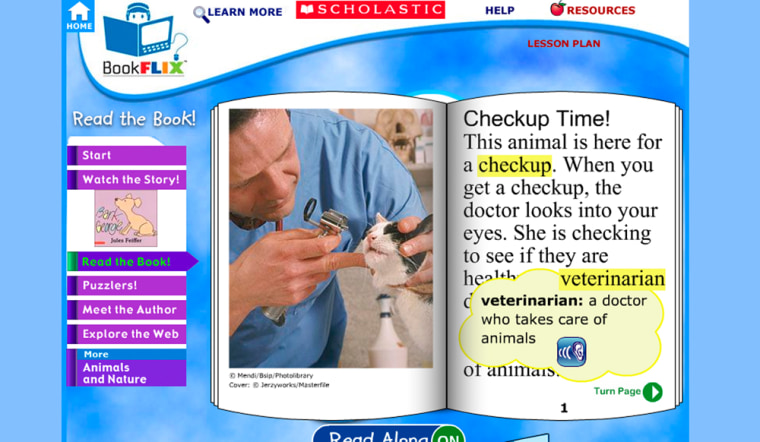Two leading children's publishers, Scholastic, Inc., and Disney, will soon discover whether the laptop compares to the lap in the hearts of young readers.
Scholastic is officially launching BookFlix, an educational Web site pairing short films based on popular picture books along with nonfiction e-books that allow early readers to follow the text online.
For example, click on the bar that reads "People and Places" and you'll find a pair of offerings on Abraham Lincoln: An animated film of a storybook, Jean Fritz's "Just a Few Words, Mr. Lincoln"; and the animated image of a nonfiction work, Will Mara's "Abraham Lincoln," with children able to turn pages, backward or forward, by clicking on an arrow on the lower right- or left-hand side.
Other books include such favorites as Jules Feiffer's "Bark, George," placed alongside Alyse Sweeney's "Pets at the Vet," and Syd Hoff's "Danny and the Dinosaur," featured with Susan H. Gray's "Dinosaur Tracks."
"We're so lucky to live in an era when kids can have books in multiple formats. Each format offers something that the other doesn't," says Francie Alexander, Scholastic's chief academic officer. "The e-book offers a wonderful ability for helping children learn to read — what academics call building `mental models.'"
Meanwhile, the Disney Publishing Group plans a similar project later this year, making favorites such as "The Jungle Book" and "Cinderella" available online. While Scholastic, for now, is sticking to the school and library market, Disney will offer books to general consumers, charging a fee, still to be determined, for downloads.
"We saw a void in the marketplace and decided to act upon it," said Jon Yaged, U.S. publisher of the Disney Book Group.
E-books for early readers come as e-sales overall have been rising quickly, even if they remain a fraction of a $35 billion dollar industry. The market for trade releases nearly doubled from 2005 to 2006, from $11 million to $20 million, and already totals $8 million in the first quarter of 2007, according to the International Digital Publishing Forum (IDPF), a trade and standards association.
IDBF executive director Nick Bogaty said he had no statistics for the educational and library market, but believed the numbers were at least triple those for commercial releases.
"It's starting to become real," Bogaty said of growth in the digital market. "Publishers are starting to take this seriously."
Unlike a few years ago, e-books have users in high places within the industry, including Penguin Group (USA) CEO David Shanks and Borders Group, Inc. CEO George Jones. Yaged remains in transition.
"I still prefer to read traditional books. ... But if our program was available right now, I would be reading it to my child," said Yaged, who added that he was reluctant to call the new Disney releases "e-books," instead favoring "digital books."
"There hasn't been enough success with the e-book. We believe it's better to call it something different."
Children's titles have been a weak part of the e-book market. Simon & Schuster and HarperCollins are among those saying they have no plans for digital texts designed for young people, while a Penguin spokeswoman said e-picture books are "part of the long-term plan," but not "the immediate future." The problem has always been a proper reading device; a laptop screen, a familiar sight for more and more children, could be the solution.
"We kept it as simple as possible. We just wanted to make sure we provided what kids would need to understand the text," Alexander says.
BookFlix begins with 80 pairings, 20 of them also available in Spanish, with categories ranging from "Family and Community" to "Music and Rhyme." Among those already using it is the Edward Smith Elementary School in Syracuse, N.Y.
"The teachers who have used it, love it," said Robin Young, the school's library media specialist. "They have been working with the kids in small groups. They love the pairing of fiction and nonfiction and they love the activities."
"We will look very carefully to see how this rolls out," said Suzanne Murphy, Scholastic's vice president of marketing for trade books, when asked if the publisher would make e-picture books available for general release.
"We have to ... look at parents today and what they're most comfortable with; and they're more and more comfortable with technology. I'd be hard pressed to say there won't be a time when bedtime reading is with an electronic device."
